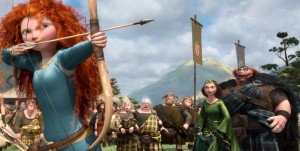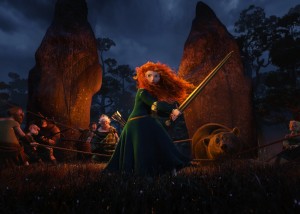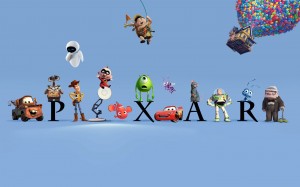Brave: Changing Our Fate
 Having children in my life has changed the way I look at the media. All year I’ve sat through movie after movie feeling neither absorbed nor entertained—except for one particular trailer that promised to “change your fate.” Though it’s usually the heat that draws us to the movie theater in the summer, we were first in line for tickets to Pixar‘s latest release, Brave. We truly enjoyed it, but I’ve found its reception in the popular press to be both encouraging and frustrating.
Having children in my life has changed the way I look at the media. All year I’ve sat through movie after movie feeling neither absorbed nor entertained—except for one particular trailer that promised to “change your fate.” Though it’s usually the heat that draws us to the movie theater in the summer, we were first in line for tickets to Pixar‘s latest release, Brave. We truly enjoyed it, but I’ve found its reception in the popular press to be both encouraging and frustrating.
Brave caught my attention because it shines a bright light on Pixar’s main failing: the majority of stories the acclaimed studio tells are about and targeted to men and boys. Released on June 22, Brave tells the story of a young, determined Scottish princess named Merida who struggles with her mother for the right to make her own way in life. The film makes a strong break from the fairy tales parent company Disney usually tells about girls’ lives: Merida is not perfectly groomed, she does not put others before herself, and though she has a good relationship with her horse, Angus, animals do not flock to Merida as if she is Mother Nature. More importantly, Merida has no interest in learning to properly present herself as a princess and she is more interested in archery than romantic love. In fact, Brave’s plot is driven by Merida’s attempts to avoid the forced marriage for which her mother has spent years grooming her. Though Brave is by no means perfect, it has won critics’ praise for being “shockingly radical for a mainstream movie” and “a much-welcome corrective to retrograde Disney heroines of the past and the company’s unstoppable pink-princess merchandising.”
Princess stories aside, Brave also has called attention to the influence of the studio’s male-dominated workplace on the stories it tells.  Brave is the first Pixar film conceived of and directed by a woman, Brenda Chapman (the film’s story is reportedly based on Chapman’s daughter), but Chapman was removed from the film in October 2011, apparently due to “creative differences.” Chapman’s dismissal raises questions about Pixar’s innovativeness—and the media industry’s attitude toward feminine formats as a whole. Time’s Mary Pols put it best: “I have no doubt there are a lot of good men at Pixar, but if they’d grown up in an environment in which it was totally normal for them to see movies with girls in the lead, maybe it wouldn’t have taken 17 years for the studio to get around to making a girl the star.”
Brave is the first Pixar film conceived of and directed by a woman, Brenda Chapman (the film’s story is reportedly based on Chapman’s daughter), but Chapman was removed from the film in October 2011, apparently due to “creative differences.” Chapman’s dismissal raises questions about Pixar’s innovativeness—and the media industry’s attitude toward feminine formats as a whole. Time’s Mary Pols put it best: “I have no doubt there are a lot of good men at Pixar, but if they’d grown up in an environment in which it was totally normal for them to see movies with girls in the lead, maybe it wouldn’t have taken 17 years for the studio to get around to making a girl the star.”
Since its first feature, Toy Story, in 1995, Pixar has built a reputation for being one of the most innovative and successful animation companies in Hollywood. Pixar’s distinctive stories and visual style have been well received by critics and audiences of all ages: its twelve major releases have earned a total of $7 billion in box office sales and a long list of honors, include Emmy, Academy, and Grammy Awards. Brave’s first weekend draw of $66.7 million keeps intact Pixar’s record of first place openings with every feature since Toy Story—in fact, Brave’s opening was Pixar’s fifth best. Despite this, many critics have suggested that Brave is a sign that parent company Disney has finally consumed Pixar’s innovativeness. For example, The Wall Street Journal warned, “This is less a film in the lustrous Pixar tradition than a Disney fairy tale told with Pixar’s virtuosity.” Salon’s review suggests that Brave is a “departure from Pixar tradition in many ways” and argues, “Brave feels a lot more like a Disney film than a Pixar film.” Indiewire asserts that Brave marks the end of Pixar’s quality entertainment, “A once-complex house of stories has been downgraded to the happy meal alternative: ‘Brave’ is a movie for six-year-olds.” Merida is spunky and adorable, but I hardly think that a female-focused film with a feminine storyline will destroy Pixar’s status. But these reviews raise important questions: if Pixar is truly a cutting-edge animation studio, why did Brave take seventeen years? And are innovation and feminine forms incompatible?
 The answers to these questions suggest that the media industry assumes that “quality” means men’s and boys’ stories packaged in normative (read: masculine) narratives. This was made clear in the Huffington Post‘s concern about “Whether young boys will push their parents to see the film once they hear that it’s a quintessential mother-daughter story with only a smattering of action set pieces.” Having endured much of what the industry has offered my son (even excluding the most offensive stuff), I can say that there is a relatively untapped, assuredly lucrative market for smart media that enriches children’s lives instead of dumbing them down—and I think it’s especially important for boys to learn to value stories by and about girls. Brave is a late, but great start, and my son and I thoroughly enjoyed it. With twin daughters growing up right behind him, I’m hoping that Brave‘s success and its positive reviews will send a strong message to studios like Pixar, encouraging them to be brave enough to produce media for girls and boys alike.
The answers to these questions suggest that the media industry assumes that “quality” means men’s and boys’ stories packaged in normative (read: masculine) narratives. This was made clear in the Huffington Post‘s concern about “Whether young boys will push their parents to see the film once they hear that it’s a quintessential mother-daughter story with only a smattering of action set pieces.” Having endured much of what the industry has offered my son (even excluding the most offensive stuff), I can say that there is a relatively untapped, assuredly lucrative market for smart media that enriches children’s lives instead of dumbing them down—and I think it’s especially important for boys to learn to value stories by and about girls. Brave is a late, but great start, and my son and I thoroughly enjoyed it. With twin daughters growing up right behind him, I’m hoping that Brave‘s success and its positive reviews will send a strong message to studios like Pixar, encouraging them to be brave enough to produce media for girls and boys alike.



Brava to “Brave”! And brava to Dr. Click for her excellent commentary. My 7-year-old son and I went to see Brave and he adored it, as did I. He has asked for a long bow for his birthday “just like the one Merida” has. He also thought it was cool that both he and Merida are rock climbers and that Merida could do it in a dress. He was also impressed that she was able to hunt well enough to feed her mother. The idea that Brave is “for six year olds” is patently ridiculous. We just spent the holiday weekend with relatives where the dinner conversation at the “adult table” was all about the Jungian aspects of “Brave” and how the struggle for Merida’s individuation and autonomy in adolescence translates to both sexes. There is a very real rending of the relationship fabric that occurs in adolescence and the challenge is to heal that bond over time, a process that necessitates changes in both parent and child. To do that, both parent and child must go through a series of transformations and learn how to bend toward each other and establish a relationship of greater reciprocity. As one of three daughters, the most powerful scene for me is when Merida’s mother (in bear form) gets in between her daughter and the rogue bear and gives a huge “back off, Buddy!” roar. It was so incredibly shocking for me to see a fairy tale in which the mother is not only alive but in which she defends her daughter even if it means her own death. My hair literally stood on end! She goes from being willingly to sacrifice her daughter to social norm and political practicality to the roaring mama bear who will kill to defend her daughter and who will die herself, if that is what is called for. I had to choke back tears at that point because that was so very different from every fairy tale I have ever encountered. At the end, it was significant that the mother now wears her hair free and loosened from her formal braids, symbolizing her changed mind and gained wisdom that has come in part from her own experience of being vulnerable prey at the mercy of her attackers. It is also important for the mother to see how capable and strong her daughter is as roles are reversed and child feeds and cares for mother. There is so much that was interesting and thought-provoking in this film, but my son just had a blast seeing it and has begged to see it again. The stereotype that boys will not relate to or engage a female heroine is simply false. Thank you, Dr. Click for sharing some of the interesting “backstory” of getting this film made.
Thanks for the great piece, Melissa, which nicely captures the context and debate around the film.
For me, the presence of a female protagonist is an important step for Pixar, and I largely enjoyed the film, but it somewhat bothered me that the “innovation” in the film stopped there. As progressive as Merida’s storyline might be, the rest of the film was remarkably sparse to me: the fact that Merida has no friends struck me as an oversimplification, the triplets felt like a token nod to younger audiences rather than characters in their own right, and the film managed to feel incredibly small (as though taking place on “sets” rather than in an actual living and breathing environment). It was as though the more complex emotions of the central storyline, touching on heteronormativity and the nuanced relationship between mother and daughter, led them to simplify everything else, a decision I haven’t felt from previous Pixar films. It felt like a film that had one brave idea—a female protagonist, which shouldn’t have to be considered brave but that’s the industrial and cultural situation we find ourselves in—and then balked at being brave in any other way.
However, I ultimately came to share Amanda Ann Klein’s great conversation with her daughter about the film, which everyone should read: http://judgmentalobserver.com/2012/07/09/brave-a-mother-and-her-daughter-weigh-in/.
Thanks for your comments Sarah and Myles! Myles, I definitely agree with your comment about Amanda’s post–I really enjoyed it, too.
I have to say, though, that I disagree with your feelings about Brave (and we may just have to agree to disagree!). I think most Pixar films (ok, most films) have one major idea that they want to get across, and everything that’s not part of that idea is flat. Yes, the triplets were a token and Merida had no friends, but I’m not sure that that takes away anything major from the story. I fully agree that the film isn’t perfect, but I think it’s flawed just like most Pixar films are.